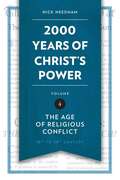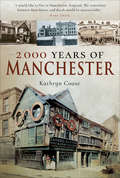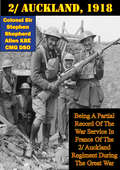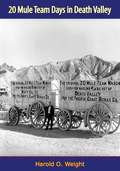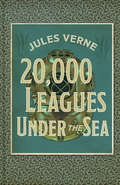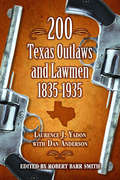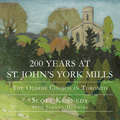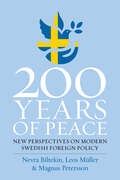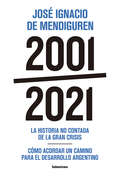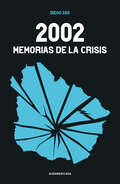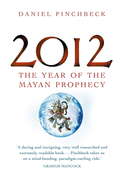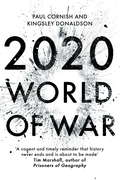- Table View
- List View
2,000 Years of Christ's Power: The Age of Religious Conflict (Grace Publications #Volume Four)
by Nick NeedhamThe Renaissance and Reformation were exciting times of learning and discovery – they pushed the boundaries of accepted thought. The repercussions of this, however, were that they left in their wake a period of universal uncertainty. The centuries–old status quo had been turned on its head. Nothing was stable anymore. Conflict ensued. The fourth volume of 2,000 Years of Christ’s Power spans from the 16th to the 18th century. It presents a time from which English Protestantism, Scottish Presbyterianism, and French Catholicism, to name only a few, were birthed and refined. Perhaps few eras have had such a direct impact on the characteristics of our own period of history.
2,000 Years of Manchester
by Kathryn CoaseAn enlightening and entertaining portrait of the English city&’s history, legends, and lore, including photos and quotations: &“Excellent.&” —NB Magazine This is not a chronological history of Manchester filled with names and dates and figures. Rather, it is an eclectic mix of fact, fiction, legend, and myth that presents the history of Manchester from its beginnings as a Roman settlement, then as an insignificant market town, to its place as a city at the heart of the Industrial Revolution and beyond—capturing not only the often tragic lives, times, struggles, and beliefs of the city&’s ever-expanding population, but also its resilience and humor. Including photographs, illustrations, poems and quotes, the book ranges from the funny, including the stories of &“Spanking Roger&” and the &“Manchester Mummy&” to the tragic stories of &“Cholera&” and &“Mary Bradley&”, together with the bizarre &“Pig Tales&” and the criminal &“Scuttlers&” and &“Purrers.&” For anyone interested in urban, social, or English history, this is a well-researched, well-written, and, most importantly, entertaining and informative read.
2.5 Minute Ride and 101 Most Humiliating Stories
by Lisa KronThis book collects Lisa Kron's two extraordinary solo performance works. Best known for her ongoing work as a member of The Five Lesbian Brothers, Kron's solo pieces are very personal examinations of both herself and her family history. This is singularly clear in 2.5 Minute Ride, where her writing deftly maneuvers between the tragic drama of the Holocaust and the wry comedy of her family's attempts to pursue pleasure at the local amusement park. This critically acclaimed work played to sold out audience for over six months at New York's Public Theatre. Also included is the riotous 101 Most Humiliating Stories, which first premiered in 1993, and in fact only consists of seventeen tales but each, as the author observes, has several humiliations. It recounts the adventures and misadventures of a self-described Big Lesbian as she tests the boundaries of decorum in social and professional situations.
2/ Auckland, 1918;: Being A Partial Record Of The War Service In France Of The 2/ Auckland Regiment During The Great War [Illustrated Edition]
by Colonel Sir Stephen Shepherd Allen KBE CMG DSOIncludes the First World War Illustrations Pack - 73 battle plans and diagrams and 198 photosColonel Sir Stephen Allen recounts, with justified pride the history of the 2nd Battalion of the Auckland Regiment, 2/Auckland for short, during the last year of the war. The 2nd Battalion formed part of the New Zealand Division and had seen much action since arriving in France in 1916; at the Battles of the Somme, Fleubaix, Messines and at Third Ypres. However the signal services of the 2/Auckland in 1918 are fully deserving of this separate tome; during the German Spring Offensives they were thrown into the line to stem the enemy advance and were the first troops to make a morale raising counterattack at La Signy Farm. As the German Army started to crack in the summer of 1918, 2/Auckland where among the foremost pursuers; at Welsh Ridge, Le Quesnoy.
20 Ground-Breaking Directors of Eastern Europe: 30 Years After the Fall of the Iron Curtain
by Marvin Carlson Kalina StefanovaDirectors have long been the main figures on Eastern European stages. During the last three decades some of the most outstanding among them have risen to international stardom thanks to their ground-breaking productions that speak to audiences far beyond local borders. Not by chance, a considerable number of these directors have won the second-biggest theatre award on the continent – the European Prize for (New) Theatrical Realities. It would not be an exaggeration to say that the top directors of the region have been pushing contemporary theatre as a whole ahead into new territories. This book offers informative and in-depth portraits of twenty of these directors, written by leading critics, scholars, and researchers, who shed light on the directors’ signature styles with examples of their emblematic productions and outline the reasons for their impact. In addition, in two chapters the selected directors themselves discuss their artistic family trees as well as the main stakes theatre faces today. The book will be of interest to theatre scholars, students, and anybody engaged with theatre on a global scale.
20 Mule Team Days in Death Valley
by Harold O. Weight“The saga of the great mule teams and giant wagons that are today’s romantic symbol of Death Valley began long before the first muleskinner piloted his lumbering borax freighters out of the Big Sink. Its roots were in that night when Aaron and Rosie Winters crouched in their darkened camp at Furnace Creek and read their future in the green-flickering flame of burning borax. But its seed went farther back.”First published in 1955, this is a wonderful book on the mule team days in California’s Death Valley during the 19th century. It contains observations on the natural history of mules and muleskinners, and the mining of desert borax. There is also a reprint of Henry G. Hanks’ Report on Death Valley from 1883.
20 Years at Hull House
by Jane AddamsHull House is a settlement house in the United States that was co-founded in 1889 by Jane Addams and Ellen Gates Starr. Located in the Near West Side of Chicago, Illinois, Hull House opened its doors to the recently arrived European immigrants. By 1911, Hull House had grown to 13 buildings. In 1912 the Hull House complex was completed with the addition of a summer camp, the Bowen Country Club. With its innovative social, educational, and artistic programs, Hull House became the standard bearer for the movement that had grown, by 1920, to almost 500 settlement houses nationally.
20 pelotazos de esperanza en tiempos de crisis
by Alberto LatiCon el estilo que lo caracteriza, el reconocido periodista deportivo Alberto Lati nos comparte 20 hechos históricos en los que el deporte trajo paz a enemigos de guerra, tiempos en los que el deporte fue patria para deportistas desplazados de su hogar, momentos cruciales en los que el deporte fue la única esperanza. De alguna manera, Alberto Lati ha escrito éste, su quinto libro, desde que comenzó su andar en los medios. Siempre intrigado por la capacidad del deporte para generar una mejor sociedad, siempre hurgando en esas canchas -o, más bien, en esos pelotazos- de los que surgió la esperanza cuando todo era crisis. Nacido en la Ciudad de México en 1978, ha radicado como corresponsal en ocho países y ha realizado coberturas en más de 100. A la par de su trabajo en medios de comunicación y su pasión por los idiomas, es colaborador del Alto Comisionado de la ONU para los Refugiados. En 2013 publicó Latitudes. Crónica, viaje y balón, reeditado como bestseller en 2016 (bajo el sello Debolsillo). En 2018 vio luz su primera novela Aquí, Borya(Grijalbo). En 2019 exploró la infancia de los mejores futbolistas con 100 genios del balón(Plan B) y en 2020 lo hizo con los más destacados atletas olímpicos con 100 dioses del Olimpo (Plan B). Aquí se encuentran crónicas y relatos de coberturas. Aquí fluyen, cual armonioso centro al área, entrevistas exclusivas con personajes como los Nobel de la Paz, Juan Manuel Santos y Lech Walesa, como el entrenador del milagro iraquí de 2007, Jorvan Vieira, como el único jugador no blanco en la coronación de 1995 que unificó a Sudáfrica, Chester Williams. Aquí 20 pelotazos de esperanza en tiempos de crisis... tan necesarios hoy.
20,000 Leagues Under the Sea: Large Print (Classics Ser.)
by Jules VerneMore than a marvelously thrilling drama, this classic science fiction novel from 1870 foretells the inventions and advanced technology of the twentieth century and has become a literary stepping-stone for generations of science fiction writers. The scholarly Professor Aronnax, loyal Conseil, and adventurous Ned Land originally set out on an expedition to find out what mysterious sea monster has been damaging world shipping, but soon find themselves face to face with the Nautilus, discovering that the mysterious monster was a submarine all along. Quickly captured and brought inside the vessel, the trio meet its enigmatic creator and commander, Captain Nemo. Torn between exploration and escaping, the travelers witness an underwater world of truth and fantasy—the corals of the Red Sea, the wrecks of battles past, and the legendary submerged land of Atlantis—led by one of the greatest villains ever created. Penguin Random House Canada is proud to bring you classic works of literature in e-book form, with the highest quality production values. Find more today and rediscover books you never knew you loved.
20.25 Quice mujeres hablan de Eva Perón
by Lilia LardoneQuince testimonios de mujeres construyen un retrato de Evita, desde unaperspectiva de género. El 26 de julio de 1952 se escuchó por radio: «Son las 20.25, hora en queEva Perón entró en la inmortalidad». El hecho marcó la historiaargentina y Eva es considerada a nivel mundial icono de la justiciasocial, más allá de los colores políticos. Cómo la recuerdan las mujeresque fueron niñas o jóvenes en aquellos años. Cómo construyó la culturaargentina la imagen pública de Eva Perón. Cómo se generó este relato delmito.Lilia Lardone ha entrevistado a quince mujeres de diversas inclinacionespolíticas, de distintas clases sociales, para armar el rompecabezas queconstituye Evita, una figura de dimensión épica. La mujer pasional,entregada, polémica, provocadora. La mujer que promovió el voto femeninoo planes de vivienda al mismo tiempo que lecturas obligatorias en lasescuelas.Con prólogo de María Teresa Andruetto, este libro fundamental analizapor primera vez, desde un punto de vista estrictamente femenino, a lamujer que cambió para siempre la historia de los argentinos.
20.25: QUINCE MUJERES HABLAN DE (EBOOK)
by Lilia LardoneEl 26 de julio de 1952 se escuchó por radio: #Son las veinte y veinticinco, hora en que Eva Perón entró en la inmortalidad#. El hecho marcó la historia argentina. A sesenta años de su muerte, Eva Perón es considerada a nivel mundial icono de la justicia social, más allá de los colores políticos. Cómo la recuerdan las mujeres que fueron niñas o jóvenes en aquellos años. Cómo construyó la cultura argentina la imagen pública de Eva Perón. Cómo se generó este relato del mito. Lilia Lardone ha entrevistado a quince mujeres de diversas inclinaciones políticas, de distintas clases sociales, para armar el rompecabezas que constituye Evita, una figura de dimensión épica. La mujer pasional, entregada, polémica, provocadora. La mujer que promovió el voto femenino o planes de vivienda al mismo tiempo que lecturas obligatorias en las escuelas. Con prólogo de María Teresa Andruetto, este libro fundamental analiza por primera vez, desde un punto de vista estrictamente femenino, a la mujer que cambió para siempre la historia de los argentinos.
200 Texas Outlaws and Lawmen, 1835–1935
by Dan Anderson Laurence YadonA lively reference covering a century’s worth of shooters, sheriffs, and more in the Lone Star State.The Lone Star State is known for producing both vicious outlaws and valorous lawmen. While Machine Gun Kelly terrorized urban civilians, lawmen such as Ranger John Barclay Armstrong tried to keep things under control. This is the story of Texas’s most famous criminals, intrepid lawmen—and in the case of James Edwin Reed, both—as well as such figures as the legendary Judge Roy Bean.This reference brings to life a time before the West was tamed, and also includes a chronology of well-known crimes and a locale list of notorious events.
200 Years Yonge: A History
by Ralph MagelThe Yonge Street as conceived by Lieutenant-Governor John Graves Simcoe is celebrated, from its beginning as a First Nation’s Trail, to the Yonge Street we know today, extending from Toronto to Innisfil. Augustus Jones, the surveyor assigned by Simcoe, the French, the German pioneers, the Loyalists – all were to influence the building of Yonge Street. With the building of a route came tolls, inns, villages, more immigrants and ultimately an avenue of economy serving as the key transportation route for the people, goods and services that represent our province.
200 Years at St. John's York Mills: The Oldest Church in Toronto
by Scott Kennedy Jeanne HopkinsThe history of the oldest parish church in the Toronto area is also the history of North Toronto and a changing culture. The War of 1812 was barely over when the people of York Mills felled the trees that would become the first St. John’s Anglican Church. Built in 1816 on land donated by pioneer settlers Joseph and Catherine Shepard, the little log church was the first outpost of St. James Church in the Town of York and the first parish church in what would one day become the City of Toronto. The brick church that stands there today, high on the land overlooking Hogg’s Hollow, was completed in 1844. Though enlarged and improved over the years, it continues to serve as a welcoming place of worship and a valuable repository of Canadian history.
200 Years of Friedrich Engels: A Critical Assessment of His Life and Scholarship (The European Heritage in Economics and the Social Sciences #25)
by Jürgen Georg Backhaus Günther Chaloupek Hans A. FrambachThis edited volume discusses the life and scholarship of Friedrich Engels. Written to commemorate the two-hundred-year anniversary of Engels’ birth, the contributions take a look into his research from a variety of viewpoints, trace the influence of his predecessors, and critically evaluate his place within 19th century scholarship. In addition, specific topics are taken up, such as his (mis)assessment of American capitalism, his influence on the Italian labor movement, the thematization of social problems and the relevance of his thought in a global economy. Providing a fresh look at the co-founder of scientific socialism, this volume will be of interest to researchers and students of contemporary political, social and economic systems, the history of economic thought, and political history.
200 Years of Peace: New Perspectives on Modern Swedish Foreign Policy
by Magnus Petersson Nevra Biltekin, Leos MüllerSince 1814 Sweden has avoided involvement in armed conflicts and carried out policies of non-alignment in peacetime and neutrality during war. Even though the Swedish government often describes Sweden as a ‘nation of peace’, in 2004 the 200-year anniversary of that peace passed by with barely any attention. Despite its extraordinary longevity, research about the Swedish experience of enduring peace is underdeveloped. 200 Years of Peace places this long period of peace in broader academic and public discussions surrounding claimed Swedish exceptionality as it is represented in the nation’s social policies, expansive welfare state, eugenics, gender equality programs, and peace.
2000 Kisses: A Novel (SEAL and Code Name #1)
by Christina SkyeA year 2000 computer glitch got her $1 million and a cowboy--and the wildest adventure of her life . . .P.R. whiz Tess O'Mara is burned out. She's looking for a change. Something wild and crazy. The year 2000 has arrived. And that's when the trouble begins. A computer glitch has deposited one million dollars into her bank account. Problem is, it's somebody else's money, somebody who's willing to kill to find it--and Tess has already spent a big chunk of it on a new wardrobe and a powder-blue Mercedes convertible. Suddenly Tess is running for her life, as fast and as far as she can go . . . . . . until she reaches the sleepy desert town of Almost, Arizona. Sheriff Jake McCall, a dead ringer for Mel Gibson, is there to catch her as she careens into town and collapses from heatstroke in his arms. Jake's prepared for anything--except the spoiled city slicker with trouble in her wake. The last thing he expects is to fall for her. But as danger tracks Tess to her door, something unexpected happens that will transform two very different people, and one dusty, dead-end town, forever . . .From the Paperback edition.
2001 - 2021. La historia no contada de la gran crisis - Cómo acordar un camino para el desarrollo argentino
by José Ignacio de Mendiguren2001: la historia no contada de la gran crisis, la debacle de la convertibilidad y la lucha contra el impulso dolarizador que puso en peligro la soberanía nacional.2021: veinte años después, la revalorización del presente y un llamado a acordar el camino al desarrollo y al progreso argentinos. Este libro revela la historia no contada del proceso que desemboca y estalla en la gran crisis de 2001. Protagonista insoslayable de aquellos días, José Ignacio de Mendiguren, por entonces presidente de la Unión Industrial Argentina, y al poco tiempo primer ministro de Producción de la Nación, traza aquí la crónica de una muerte anunciada mucho antes que lo había encontrado batallando primero contra el modelo de la convertibilidad de los 90 y después contra la fenomenal presión en favor de la dolarización del 2000. Releer el 2001 a la luz de su mirada sirve para completar la comprensión del drama pasado, pero sobre todo para revalorizar el potencial del presente y plantear los desafíos del futuro. En efecto, a veinte años de ese punto de inflexión en la historia argentina contemporánea, Mendiguren propone consensuar un rumbo que permita al país reencontrar su destino soberano y encaminarse al desarrollo inclusivo por el que ha venido bregando a lo largo de su dilatada trayectoria tanto en el ámbito privado como en el público.
2002: Memorias de la crisis
by Diego ZasEl periodista Diego Zas, a 20 años de una de las crisis económicas, políticas y sociales más profundas que tuvo Uruguay, nos relata en ágiles historias los entretelones de ese momento que marcara a un país. En 2002: memorias de la crisis Zas repasa el papel en aquel entonces del presidente Jorge Batlle visto por propios y ajenos; las negociaciones con el FMI; la relación de Batlle y George Bush; el rol del Frente Amplio; cómo un dirigente de AEBU, el gobierno y un medio de prensa intentaron frenar la corrida bancaria en un acuerdo secreto; la figura de Atchugarry y la articulación con el sistema político. Pero también preguntas que siguen en el aire: ¿existieron las hordas del Cerro?, ¿quién organizó los saqueos?, ¿hubo niños que comieron pasto? Con entrevistas exclusivas y removedoras, revelaciones importantes por parte de agentes políticos de la época y un trabajo de recopilación de archivo de magnitud, Zas logra revelar una foto de un pasado no tan lejano que dejó marcas en esta penillanura levemente ondulada llamada Uruguay. Un libro fundamental para la historia del país.
2012: The year of the Mayan prophecy
by Daniel Pinchbeck2012 is a literary and metaphysical epic that binds together the cosmological phenomena of our time, ranging from crop circles to quantum theory to the worldwide resurgence of shamanism, supporting the Mayan prophecy that the year 2012 will bring an unprecedented global shift. In tracing the meaning of the prophetic Mayan 'end date' of 2012 to our present society, Daniel Pinchbeck draws together alien abductions, psychedelic visions, the current ecological crisis and other peculiar aspects of 21st century life into a new vision for our time. 2012 heralds the end of one way of existence and the return of another, in which the Mesoamerican God Quetzalcoatl returns, bringing with him an ancient - yet to us, wholly new - way of living. There are many hints, both in quantum theory and elsewhere, that humanity is precariously balanced between greater self-potential and environmental disaster. Pinchbeck's journey, which takes us from the endangered rainforests of the Amazon to Stonehenge in England, tells the story of a man in whose trials we recognise our own hopes and anxieties about modern life.
2013 | The Little Data Book
by World BankThis pocket-sized reference on key development data for over 200 countries provides profiles of each country with 54 development indicators about people, environment, economy, technology and infrastructure, trade, and finance.
2016-2017 Directory of American Politics: The Definitive Guide to Political Organizations and Resources in the United States
by Arlander C. BrownThe 2015-2016 edition of The Directory of American Politics is the most comprehensive listing of government and private political organizations yet published, with information on the offices of federal and state elected officials, interest groups, media outlets, Super PACs, and registered lobbyists-in short, an exhaustive listing of every significant organization and individual involved in the American political system.Each entry contains detailed contact information, including names, addresses, and telephone numbers. Also included are selected email and Internet addresses, websites, descriptions of committee assignments, senior staff by name and responsibility, a listing of sponsored legislation, and more. Entries are categorized by state, including those for congressional office holders, and are indexed alphabetically and by subject on topics ranging from voting records to campaign finance. Each person listed in the directory is also indexed alphabetically.
2020: World of War
by Kingsley Donaldson Paul Cornish'A timely and cogent reminder that history never ends and is about to be made' - Tim Marshall, author of Prisoners of GeographyWith the world already struggling to contain conflicts on several continents, with security and defence expenditure under huge pressure, it's time to think the unthinkable and explore what might happen.As former soldiers now working in defence strategy and conflict resolution, Paul Cornish and Kingsley Donaldson are perfectly qualified to guide us through a credible and utterly convincing 20/20 vision of the year 2020, from cyber security to weapons technology, from geopolitics to undercover operations.This book is of global importance, offering both analysis and creative solutions - essential reading both for decision-makers and everyone who simply wants to understand our future.
2020: World of War
by Kingsley Donaldson Paul Cornish'A timely and cogent reminder that history never ends and is about to be made' - Tim Marshall, author of Prisoners of GeographyWith the world already struggling to contain conflicts on several continents, with security and defence expenditure under huge pressure, it's time to think the unthinkable and explore what might happen.As former soldiers now working in defence strategy and conflict resolution, Paul Cornish and Kingsley Donaldson are perfectly qualified to guide us through a credible and utterly convincing 20/20 vision of the year 2020, from cyber security to weapons technology, from geopolitics to undercover operations.This book is of global importance, offering both analysis and creative solutions - essential reading both for decision-makers and everyone who simply wants to understand our future.
2020: World of War
by Kingsley Donaldson Paul Cornish' A timely and cogent reminder that history never ends and is about to be made' - Tim Marshall, author of Prisoners of GeographyThe year is 2020 and civilisation is on the verge of a Third World War. Will the Russian invasion of the Arctic trigger the military response called for in the NATO treaty? Will the simultaneous Chinese cyber-attack on the Pentagon cripple the world's biggest military machine?Who's arming the refugees in the migrant camps on the shores of the Mediterranean? What's happening in space?From cyber security to weapons technology, from economics to robotics, from geopolitics to undercover operations, 2020: World of War will offer us a compelling account of the shape our world will take in the future. Told through a number of gripping scenarios, all reality-based, all using the authors' experience and inside knowledge of the way the world works, whether inside the Pentagon or on the front line of international conflict, this book is a must for everyone who wants to understand what our future looks like.(P) 2017 Hodder & Stoughton
